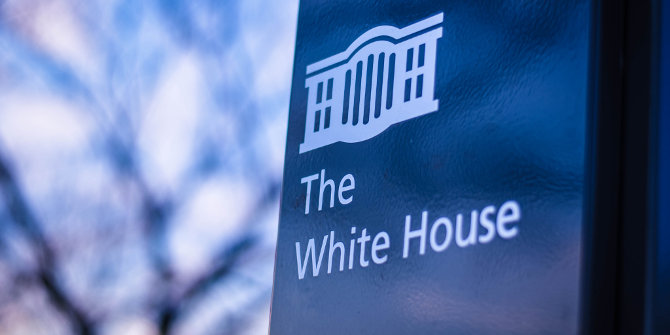 This fall voters in Kentucky will go to the polls to choose the state’s next governor. While the election is happening in an off year, meaning that the presidency will not be on the ballot, the result may help us understand what may happen in key races in 2024, argues Anne Cizmar. She writes that despite Kentucky’s move to the right in recent years, the incumbent Democratic Governor, Andy Beshear, is popular and has a fundraising advantage, while his Republican rival, Daniel Cameron, faces a factionalized party. Beshear’s performance may provide clues as to how other Democratic candidates will perform next year in increasingly Republican states, like Ohio.
This fall voters in Kentucky will go to the polls to choose the state’s next governor. While the election is happening in an off year, meaning that the presidency will not be on the ballot, the result may help us understand what may happen in key races in 2024, argues Anne Cizmar. She writes that despite Kentucky’s move to the right in recent years, the incumbent Democratic Governor, Andy Beshear, is popular and has a fundraising advantage, while his Republican rival, Daniel Cameron, faces a factionalized party. Beshear’s performance may provide clues as to how other Democratic candidates will perform next year in increasingly Republican states, like Ohio.
- ‘This article is part ‘The 2024 Elections’ series curated by Peter Finn (Kingston University). Ahead of the 2024 election, this series is exploring the US elections at the state and national level. If you are interested in contributing to the series contact Peter Finn (p.finn@kingston.ac.uk).’
Many are watching the Kentucky gubernatorial election scheduled for this November. It is one of the few off-year elections occurring in 2023, with neither the presidency nor members of Congress on the ballot. This race is interesting to watch because the current governor is a Democrat, despite the state’s movement toward Republicans in the last few decades. The outcome of Kentucky’s gubernatorial race may provide clues about key races in the upcoming 2024 elections.
Trending red in the Bluegrass State
Kentucky has been shifting Republican for some time. The state went easily for Trump in both 2016 and 2020, with Trump winning more than 62 percent of the vote in both elections. Kentucky has voted for the Republican presidential candidate in 9 out of the past 11 United States presidential elections—only breaking for Democrat Bill Clinton by narrow margins in 1992 and 1996.
Out of Kentucky’s members in the United States Congress, five out of six members of the House of Representatives are Republicans—only the Louisville area has a Democratic representative. Both senators are Republicans, including Senator Mitch McConnell, who has been serving in the Senate since 1984 and is the Senate Minority Leader.
In terms of state offices, Kentucky has also seen a trend toward the GOP. In 2016, the Republican Party took back control of the Kentucky House for the first time in nearly 100 years. In 2022, Republicans expanded upon their majorities in both the Kentucky House and Senate.
A popular Democrat in a red state
Despite the rightward movement in the state, Democrat Andy Beshear was elected as governor in 2019. Facing reelection this year, he easily secured the Democratic nomination this past May, winning more than 90 percent of the vote in the primaries. He also won a clear majority in all counties around the state.
As with his last election in 2019, he faces stiff opposition for the governorship. This will be a competitive race. In a crowded Republican field of more than 10 candidates, Daniel Cameron won the nomination. The eagerness of Republicans to compete in the gubernatorial primary likely cues that Republicans feel Beshear is vulnerable in his reelection bid.
Cameron is a formidable challenger. He already holds statewide office as Attorney General and has considerable name recognition in the state. He is the first Black official that was elected to statewide office in Kentucky. He also boasts former President, Donald Trump’s support, and connections to Senator McConnell. As Attorney General, he made headlines for combating Beshear’s COVID-19 era executive orders.
The COVID-19 response appears to be a key factor for his candidacy; Republicans balked over the governor’s pandemic policies related to COVID-19. The governor made controversial decisions over closures and masks that stirred resentment among some in the community. Limiting government mandates, both in Kentucky and Washington, D.C., appears to be a central theme in this campaign materials.
As it stands in June 2023, however, Beshear is popular. It seems that many are ready to put COVID-19 behind them rather than rehashing the pandemic years. Meanwhile, Beshear has received much public support for his handling of several disasters in the state, including a devastating tornado in December 2021, and historic flooding in eastern Kentucky in July 2022.

“2020.09.13 Appeal to Vote, Washington, D” (CC BY-SA 2.0) by tedeytan
Beshear has the advantage going into the election
Beshear also has several advantages going into the general election. First, Beshear did not need to spend much money on the primary campaign and has his war chest of more than $3.2 million intact. Cameron had to spend down a good bit of money to beat Kelly Craft and other Republicans in the primary. Second, the bitter Republican primary may also result in cracks in the Republican Party’s base of voters. Cameron received less than 50 percent of the Republican primary votes in the state, with nearly 22 percent of voters for Ryan Quarles, 17 percent for Kelly Craft, and another 13 percent spread over multiple candidates. Whereas the Democratic base was solidified behind the incumbent, Republicans were factionalized among different candidates. Cameron will need to win support from the disparate factions of the party to win the governorship.
Kentucky’s off-year gubernatorial election may also advantage Beshear. Trump is very popular in Kentucky, but his name is not on the ballot. Although Cameron will certainly tout Trump’s endorsement of his candidacy, he cannot count on the mobilization effect of Trump turning out voters to the polls in the same way as if Trump was a candidate too. Plenty of discussion of national politics—particularly Trump versus Biden—can still be expected in this race, though.
The Republican primary election included nationalization of a statewide election. What some consider a proxy-war between Trump and Ron DeSantis—Florida’s governor and candidate for the GOP presidential primary—played out in the waning days of the Kentucky GOP primary. DeSantis issued a late endorsement for Kelly Craft, one of Cameron’s primary challengers. What makes the DeSantis endorsement so interesting is not that “Trump beat him” in the primary proxy-war, per se, but that DeSantis’s reading of politics was so off. The decision to issue a last-minute endorsement of a candidate is perplexing.
What the Kentucky result may mean for down ballot races in 2024
The Kentucky gubernatorial election’s outcome does not provide much information about how the state will vote in the presidential election. The state has become increasingly conservative in recent years and likely will vote for the GOP presidential candidate, particularly if it is Trump. However, the Kentucky gubernatorial race may provide clues to how other similarly situated candidates could fair in 2024. When watching other Democratic candidates in increasingly Republican states, Kentucky’s gubernatorial race may provide clues about the chances for those Democrats to survive.
Looking to Kentucky’s northern neighbor, Ohio is expected to have a hotly contested US Senate race in 2024. The incumbent senator, Sherrod Brown, is also an isolated Democrat in an increasingly red state. Like Beshear, he has a track record within his state that has so far resonated with voters, despite the Republican movement in the state overall. These races are certainly different in many respects, but Democratic success in Kentucky may bode well for Democrats in 2024.
- Please read our comments policy before commenting.
- Note: This article gives the views of the author, and not the position of USAPP – American Politics and Policy, nor the London School of Economics.
- Shortened URL for this post: https://bit.ly/42yOuiu






